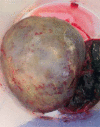Case report of ovarian torsion mimicking ovarian cancer as an uncommon late complication of laparoscopic supracervical hysterectomy
- PMID: 28250728
- PMCID: PMC5327626
- DOI: 10.5114/pm.2016.65669
Case report of ovarian torsion mimicking ovarian cancer as an uncommon late complication of laparoscopic supracervical hysterectomy
Abstract
Laparoscopic supracervical hysterectomy (LSH) is an example of a partial hysterectomy, performed due to benign gynaecological complaints. Better endoscopic instruments and operational techniques have led to a great reduction in the number of abdominal hysterectomies. It is believed that LSH is a safe and minimally invasive hysterectomy technique. The Cochrane Database meta-analysis proves the benefits of minimally invasive surgery compared with abdominal gynaecological surgery, including decreased pain, surgical-site infections and hospital stay, quicker return to activity, and fewer postoperative adhesions. According to recent publications, the overall complication rate of all hysterectomy methods is about 1-4.5%. Adnexal torsion is a correlated complication. About 3-5% of patients undergoing emergency surgery due to pelvic pain are diagnosed with this condition. It may be the cause of acute abdomen and correlated symptoms such as vomiting, nausea, or severe pain. To the best of our knowledge a case of asymptomatic, delayed ovarian torsion mimicking ovarian tumour has not been reported so far. In the presented case, torsion successfully imitated neoplastic process as both ROMA score and IOTA 'simple rules' indicated a malignancy with high degree of probability. This case demonstrates that, if ovarian tumour is detected in the postoperative period, a torsion of ovarian pedicle should be taken into consideration as it may mimic malignant neoplasm.
Keywords: LSH; adnexal torsion; laparoscopy; ovarian cancer; supracervical hysterectomy.
Figures
Comment in
-
Comment on: Case report of ovarian torsion mimicking ovarian cancer as an uncommon late complication of laparoscopic supracervical hysterectomy.Prz Menopauzalny. 2017 Mar;16(1):26-28. doi: 10.5114/pm.2017.67368. Epub 2017 Apr 26. Prz Menopauzalny. 2017. PMID: 28546805 Free PMC article. No abstract available.
References
-
- Wu JM, Wechter ME, Geller EJ, et al. Hysterectomy rates in the United States, 2003. Obstet Gynecol. 2007;110:1091–1095. - PubMed
-
- American College of Obstetricians and Gynecologists. Committee Opinion No. 444: Choosing the route of hysterectomy for benign disease. Obstet Gynecol. 2009;114:1156–1158. - PubMed
-
- Deffieux X, Rochembeau B, Chene G, et al. Hysterectomy for benign disease: clinical practice guidelines from the French College of Obstetrics and Gynecology. Eur J Obstet Gynecol Reprod Biol. 2016;202:83–91. - PubMed
Publication types
LinkOut - more resources
Full Text Sources
Other Literature Sources



